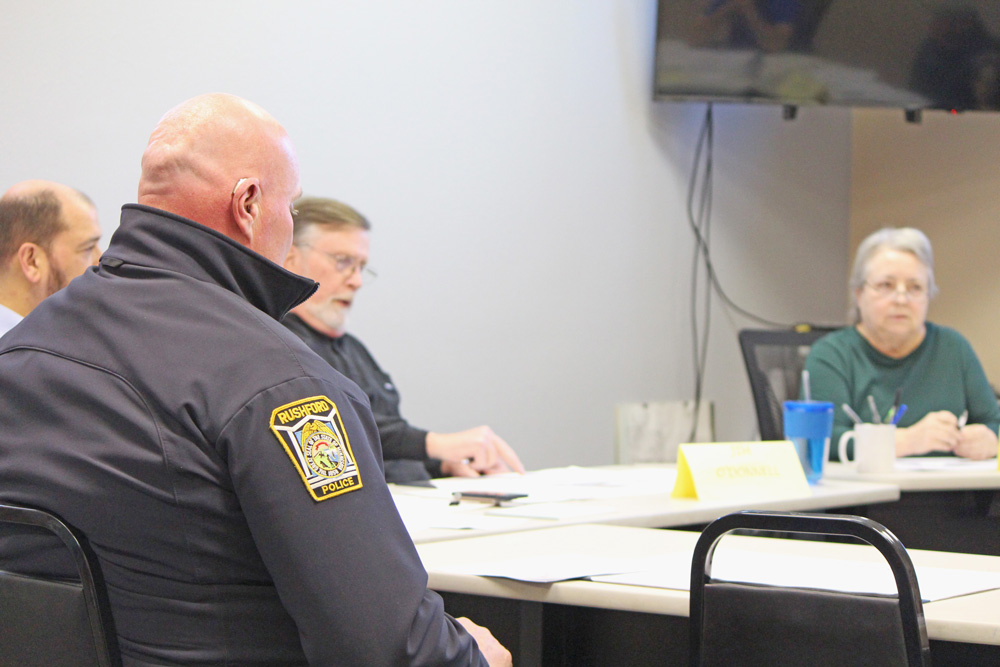After careful consideration, the Rushford Council unanimously approved implementing a Body Worn Camera Program for the Rushford Police Department officers. Rushford Police Chief Adam Eide was present at the March 24 meeting to answer any questions.
Notice was published and posted encouraging interested persons to provide comments and/or attend the public hearing. According to the city clerk, there were no concerns received by city hall ahead of the meeting and only one member of the public was present at the hearing.
Lynn Humble, former Rushford Ambulance Director was the sole citizen attendee of the hearing and expressed her opinion in favor of the program. “I’m glad they’re getting them and glad they’re going forward,” said Humble. “Yes!”
“I think that’s a sign that it’s not a big concern,” stated Mayor Terri Benson, referencing the lack of citizens present at the hearing. “It’s a safety measure not only for you guys, but for the community, too. That’s important.”
The cameras haven’t arrived yet and there are still preparatory steps to take before officers can begin wearing them. Eide anticipated the department would employ the cameras sometime in April.
Also in attendance at the meeting was Bill Spitzer, director of Transportation, Semcac Transportation – Rolling Hills Transit. This was Spitzer’s second visit to the council and he spoke regarding financial support, enhancing reach of rural public transit services and other initiatives taken by Semcac.
“The good news is you have a brand new bus and I brought it with me tonight,” he began. “I promised last time to make these visits a little more regular.”
A year ago, with the cost of a new bus looming, the council approved providing $2,500 a year for five years to Rolling Hills Transit utilizing revenue from Public, Educational, and Government fees to fund the cost. This year, Spitzer stated that the service has a $1.7 million budget and they are responsible for 5% of that. Next year, the contribution increases to 10%. The other 90% remains federal dollars funneled through the Minnesota Department of Transportation.
“Will that be viable in the future?” asked Councilor Jim O’Donnell.
“We hope,” Spitzer responded. “This isn’t anything new for public transit. They’ve been contributing for many, many years. Hopefully we’re not impacted by any shutdowns. A lot of the money is already encumbered by the state of Minnesota.”
Spitzer was to meet with 19 entities, including cities and counties, in the first half of 2024 to better educate them on the service and needs. He provided an update to this at the meeting, noting the service had gotten support from eight communities, who contributed between $15,000-36,000. Rushford was one of two cities that elected to do annual contributions. According to Spitzer, the others opted for a one-time contribution, with most having already set aside funds for the expenditure.
To increase ridership, Rolling Hills Transit rebranded all of its marketing materials and made a more concerted effort to inform the public about the services. There were 50,067 total rides systemwide with Fillmore County, serving Rushford, Chatfield and Spring Valley, tallying 72,070. In Rushford, there were more than 3,000 rides over the year, with an average of 13 a day, 12,389 miles and 1,746 hours driven. Of the 351 rides given in 2025, they included two handicapped, 20 elderly, 44 adults, 26 students and 259 preschool students. A new Volunteer Driver Program and caravan service, for mobility-challenged riders, are also new, as is a, “Got Bike Need Lift” campaign. A survey will be put out to each community.
The council also discussed recommendations changing the layout, policy and fees charged for the use of the North End Campground. In the new layout, spaces one through seven will be designated for large RVs while spaces eight through 10 will be dedicated for tent camping. The council referenced events last year where there were an excessive number of campers in the spaces and there was extreme difficulty in access with vehicles, due to some of the terrain, ultimately leading to one hitting a transformer. This is also problematic as the number of campers cannot safely fit in the provided storm shelter in case of emergency or use the restrooms and showers accordingly.
Zacher noted that employees of the store where camping passes are purchased weren’t always trained on proper booking and there were instances of reservation spaces being filled, requiring the city to ask the non-reserved camper to leave, and too many campers being booked in general. This year, the city will curb those issues with recording practices and policies, including a 2 p.m. check-out time. Campers will receive a bright tag to attach to their vehicle, camper or tent to be easily identified by city staff. The city is also increasing the cost to rent sites. All information will be on the city website.
Lastly, the council discussed the Rushford Electric Commission Meeting details and recommendations particularly the MiEnergy rate study and unanimously approved undergoing a rate study with MiEnergy. It presents a large cost savings over the city conducting it independently. The city’s engineer will review the study.
“It was a very good meeting. We appreciate MiEnergy’s willingness to help with some things. They’ve always been very good, but it was on full display,” said councilor and commission member Sally Ryman. “Our rates are out of line with rates as far as a fixed charge. Ours haven’t been adjusted in some time. They’re way out of line.”
The last Rushford rate study was in 2012. “We’re not going to say that we’re going to go to their rates, but we’re going to look at our rates, classes and needs,” added Ryman. “We’re not talking about raising things a huge percentage. When they see their line item, I don’t anticipate any of them will see a big change.”



Leave a Reply